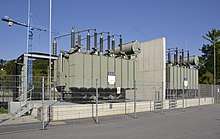High-voltage transformer fire barriers
High-voltage transformer fire barriers, or transformer firewalls, transformer ballistic firewalls, transformer blast walls, are outdoor countermeasures against cascading failures in a national electric grid. The purpose of these barriers, like common fire barriers in building construction, is compartmentalisation of transformer fires, as well as transformer and bushing explosions where the fuel source of both fires and explosions is the transformer oil. Without compartmentalisation, one ruptured transformer could start its neighbouring transformer on fire and thus create a domino effect that can affect the surrounding electric grid, particularly during peak times.

High-voltage transformer fire barriers are typically located in electrical substations, but may also be attached to buildings, such as valve halls or manufacturing plants with large electrical distribution systems, such as pulp and paper mills. Outdoor transformer fire barriers that are attached at least on one side to a building are referred to as wing walls. At times, high-voltage transformers can be located immediately outside and sometimes inside of buildings, requiring higher fire-resistance ratings than other fire compartments in a building.[1]
Voluntary recommendations by NFPA 850
The primary North American document that deals with outdoor high-voltage transformer fire barriers is NFPA 850.[2] NFPA 850 outlines that outdoor oil-insulated transformers should be separated from adjacent structures and from each other by firewalls, spatial separation, or other approved means for the purpose of limiting the damage and potential spread of fire from a transformer failure.
Alternatives or enhancements to transformer fire barriers
The following may be used in place of or in addition to transformer fire barriers, depending on the design goals. They are not necessarily, however, compensatory measures against ballistic attacks or other sabotage.[3]
Automatic fire suppression systems
Fire protection water spray systems are used to cool a transformer to prevent damage if exposed to radiation heat transfer from a fire involving oil released from another transformer that has failed.[4]
Transformer Fast Depressurization Systems (FDS)
Passive mechanical systems designed to depressurize the transformer a few milliseconds after the occurrence of an electrical fault.[5] Those system prevent any fire by avoiding transformer tank rupture and subsequent fire damages.[6]
Alternatives to mineral-based transformer oil
Transformer oil is available in different levels of ignitability, including those approved by FM Global.[7] FM Data Sheet 5-4 indicates different levels of protection depending on the type of fluid used. Alternatives include, but are not limited to, esters and silicone oil.[8]
See also
| Wikimedia Commons has media related to High-voltage transformer fire barriers. |
| Wikimedia Commons has media related to Asymmetrical fire barriers. |
| Wikimedia Commons has media related to Time/Temperature Curves. |
References
- Ecmweb.com article entitled "Article 450: Transformers and Transformer Vaults" by Mike Holt, dated 01. May 2008, Search for "Vault construction" Paragraph
- "NFPA 850 Recommended Practice for Fire Protection for Electric Generating Plants and High-Voltage Direct Current Converter Stations". NFPA.org.
- FM Global Data Sheet 5-4 Transformers
- FM Global Data Sheet 5-4 Transformers https://www.fmglobal.com/research-and-resources/fm-global-data-sheets
- NFPA 850
- FDS Live Test
- Transformers and transformer fluids
- "Comparison of Silicone Oil and Mineral Oil Transformers". GlobeCore.com.